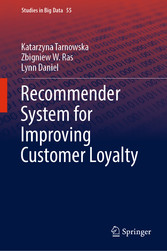Suchen und Finden
Service

Recommender System for Improving Customer Loyalty
Katarzyna Tarnowska, Zbigniew W. Ras, Lynn Daniel
Verlag Springer-Verlag, 2019
ISBN 9783030134389 , 133 Seiten
Format PDF, OL
Kopierschutz Wasserzeichen
Geräte
Preface
6
About the Book
7
Contents
8
List of Figures
12
List of Tables
15
1 Introduction
17
1.1 Why Customer Experience Matters More Now?
17
1.2 Top (and Bottom) Line Reasons for Better Customer Experience
19
1.3 What is Next?
21
1.4 Final Observations
21
2 Customer Loyalty Improvement
23
2.1 Introduction to the Problem Area
23
2.2 Dataset Description
24
2.3 Decision Problem
25
2.4 Problem Area
25
2.4.1 Attribute Analysis
25
2.4.2 Attribute Reduction
26
2.4.3 Customer Satisfaction Analysis and Recognition
26
2.4.4 Providing Recommendations
27
Reference
27
3 State of the Art
28
3.1 Customer Satisfaction Software Tools
28
3.2 Customer Relationship Management Systems
29
3.3 Decision Support Systems
29
3.4 Recommender Systems
29
3.4.1 Recommender Systems for B2B
30
3.4.2 Types of Recommender Systems
31
3.4.3 Knowledge Based Approach for Recommendation
32
3.5 Text Analytics and Sentiment Analysis Tools
32
References
33
4 Background
35
4.1 Knowledge Discovery
35
4.1.1 Decision Reducts
35
4.1.2 Classification
37
4.1.3 Action Rules
38
4.1.4 Clustering
40
4.2 Text Mining
40
4.2.1 Sentiment Analysis
40
4.2.2 Aspect-Based Sentiment Analysis
41
4.2.3 Aspect Extraction
43
4.2.4 Polarity Calculation
45
4.2.5 Natural Language Processing Issues
46
4.2.6 Summary Generation
46
4.2.7 Visualizations
47
4.2.8 Measuring the Economic Impact of Sentiment
49
References
51
5 Overview of Recommender System Engine
54
5.1 High-Level Architecture
54
5.2 Data Preparation
56
5.2.1 Raw Data Import
56
5.2.2 Data Preprocessing
58
5.3 Semantic Similarity
62
5.4 Hierarchical Agglomerative Method for Improving NPS
64
5.5 Action Rules
66
5.6 Meta Actions and Triggering Mechanism
67
5.7 Text Mining
68
References
70
6 Visual Data Analysis
71
6.1 Decision Reducts as Heatmap
71
6.2 Classification Visualizations: Dual Scale Bar Chart and Confusion Matrix
73
6.3 Multiple Views
74
6.4 Evaluation Results
74
6.4.1 Single Client Data (Local) Analysis
75
6.4.2 Global Customer Sentiment Analysis and Prediction
76
6.5 User-Friendly Interface for the Recommender System
77
7 Improving Performance of Knowledge Miner
80
7.1 Introduction
80
7.2 Problem Statement
80
7.3 Assumptions
81
7.4 Strategy and Overall Approach
82
7.5 Evaluation
84
7.5.1 Experimental Setup
84
7.5.2 Results
85
7.5.3 New Rule Format in RS
89
7.6 Plans for Remaining Challenges
96
Reference
96
8 Recommender System Based on Unstructured Data
97
8.1 Introduction
97
8.2 Problem Statement
97
8.3 Assumptions
97
8.4 Strategy and Overall Approach
99
8.4.1 Data Transformation
99
8.4.2 Action Rule Mining
100
8.4.3 Ideas for the Improvement of Opinion Mining
101
8.4.4 Sentiment Extraction
101
8.4.5 Polarity Calculation
102
8.5 Evaluation
103
8.5.1 Initial Experiments
103
8.5.2 Experimental Setup
103
8.5.3 Improving Sentiment Analysis Algorithm
104
8.5.4 Experimental Results
108
8.5.5 Modified Algorithm for Opinion Mining
110
8.5.6 Comparing Recommendations with the Previous Approach
112
8.6 Plans for Remaining Challenges
116
8.6.1 Complex and Comparative Sentences
117
8.6.2 Implicit Opinions
118
8.6.3 Feature and Opinion in One Word
118
8.6.4 Opinion Words in Different Context
119
8.6.5 Ambiguity
119
8.6.6 Misspellings
120
8.6.7 Phrases, Idiomatic and Phrasal Verbs Expressions
120
8.6.8 Entity Recognition From Pronouns and Names
120
References
121
9 Customer Attrition Problem
122
9.1 Introduction
122
9.2 Problem Statement
122
9.3 Assumptions
124
9.4 Strategy and Overall Approach
124
9.4.1 Automatic Data Labelling
124
9.4.2 Pattern Mining
125
9.4.3 Sequence Mining
126
9.4.4 Action Rule, Meta Action Mining and Triggering
126
9.5 Evaluation
126
9.5.1 Initial Data Analysis
127
9.5.2 Attribute Selection
127
9.5.3 Classification Model
128
9.5.4 Action Rule Mining
129
9.6 Plans for Remaining Challenges
131
Reference
131
10 Conclusions
132
10.1 Contribution
132
10.2 Future Work
133
Shop


